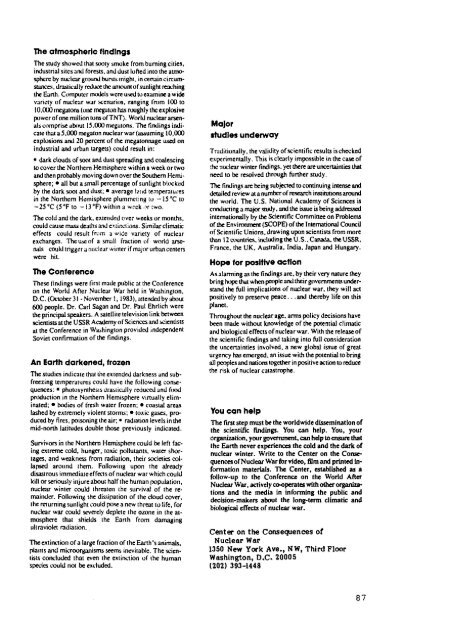Ifda dossier 47, May/June 1985
Ifda dossier 47, May/June 1985
Ifda dossier 47, May/June 1985
You also want an ePaper? Increase the reach of your titles
YUMPU automatically turns print PDFs into web optimized ePapers that Google loves.
The atmospheric findings<br />
Thestudy showedthat sooty imoke from burningcities,<br />
industrial sites and forests, and dust lofted into the aunosphere<br />
by nuclear ground burstsmight. incertaincircumsiiinces.<br />
JrariiciiJly reduce theamount ofsunlight reaching<br />
the Earth. Computer models were ud to examine a wide<br />
variety of nuclear war scenarios, ranging from 100 to<br />
10.000 megatons (oiie megaton has roughly thc explosive<br />
power ofone million IonsofTNT). Work! nucleararsenali<br />
comprise about 15.000 niegatons. The finding:! indicate<br />
that a5.000 megaton nuclear war (assuming 10,000<br />
explosions and 20 percent of the megatonnage used on<br />
industrial and urban targets) could result in:<br />
dark clouds of soot and dust spreading and coalescing<br />
to cover the Northern Hemisphere within a week or two<br />
and then probably movingdownover the Southern Hemi-<br />
sphere; all but a small percentage of sunlight Mocked<br />
by the dark soot and dust; average 1a:id te.-nperaiu:'es<br />
in the Northern Hemisphere plummcim$ in - 15'C to<br />
-25'C ($'F to - 13T) within a w:ek .:r :WO.<br />
The cold and the dark. exte~tded over weeks or months.<br />
could cause ma&s deaths and eç.tiixiions Similar climatic<br />
effects could result frum a wide variety of nuclear<br />
exchanges. Theueof a small fraction of world arsenaLs<br />
could trtgget ii nucle~r winter if major urbancenters<br />
were hit.<br />
The Conference<br />
These findings were first made public at the Conference<br />
on the World After Nuclear War held in Washington.<br />
D.C. (October 3 1 -November 1, 1983), attended by about<br />
600 people. Dr. Car1 Sagan and Dr. Paul Ehrlich were<br />
the principal speakers. A satellite television link between<br />
scientists at the USSR Academy of Sciencesand scientists<br />
at the Conference in Washington provided independent<br />
Soviet confirmation of the findings.<br />
An Earth darkened, frozen<br />
The Studies indicate that he extended darkness and subfreezing<br />
temperatures could have the following consequences:<br />
photosynthesis dra~ticiilly reduced and food<br />
pritduction in the Northern Hemisphere virtually eliminated:<br />
bodies of fresh water frozen: coasial areas<br />
lashed by extremely violent storms; toxic gases, produced<br />
by fires, poisoning the air; * radiation levels in the<br />
mid-north latitudes double those previously indicated.<br />
Survivors in the Northern Hemispherecould be left fac-<br />
ing extreme cold, hunger, toxic pollutants, water shor-<br />
tages, and weakness from radiation, their societies col-<br />
lapsed around them. Following upon the already<br />
disastrous immediate effects of nuclear war which could<br />
kill or seriously injureabout half the human population,<br />
nuclear winter could threaten the survival of the re<br />
minder. Following the dissipation of the cloud cover,<br />
the returning sunlight could posea new threat to life, for<br />
nuclear war could severely deplete the ozone in the at-<br />
mosphere that shields the Earth from damaging<br />
ultraviolet radiation.<br />
Theextinction of a large fraction of the Eanh'sanimals,<br />
plants and micrwrgmisfm seem inevitable. The scien-<br />
lists concluded that even the extinciion of the human<br />
species could not be excluded.<br />
Major<br />
studies underway<br />
Traditionally. the validity of scientific results is checked<br />
esperimentally . This is clearly impossible in the case of<br />
;he nuclear winter findings. yet there are uncertainties that<br />
need to be resolved through further study.<br />
The findings are being subjected to continuing intense and<br />
detailed review at a numberof research institutionsaround<br />
the world. The U.S. National Academy of Sciences is<br />
conducting a major study. and the issue is being addressed<br />
internationally by the Scientific Committee on Problems<br />
of the Environment (SCOPE) of the International Council<br />
of Scientific Unions, drawing upon scientists from more<br />
than 12countries. includingthe U.S..Canada.theUSSR.<br />
France. the UK, Australia, India. Japan and Hungary.<br />
Hope for positive action<br />
As alarming as the findings are. by their very nature they<br />
bring hope that when people and their governmenu undcr-<br />
stand the full implications of nuclear war, they will act<br />
positively to preserve peace. . .and thereby life on this<br />
planet.<br />
Throughout the nuclear age, arms policy decisions have<br />
been made without knowledge of the potential climatic<br />
ad biological effects of nuclear war. With the releaseof<br />
the scientific findings anti taking into full consideration<br />
the uncertainties involved. a new elobal issue of ereat<br />
urgency has emerged. an issue with the potential to bring<br />
all peoples and nations together in positive action to reduce<br />
the risk of nuclear catastrophe.<br />
You can help<br />
The first step must be the worldwide dissemination of<br />
the scientific findings. You can help. You, your<br />
organization, your government, can help to ensure that<br />
the Earth never experiences the cold and the dark of<br />
nuclear winter. Write to the Center on the Conse-<br />
quences of Nuclear War for video, film and printed in-<br />
formation materials. The Center, established as a<br />
follow-up to the Conference on the World After<br />
Nuclear War, actively cooperates with other orga-<br />
tiow and the media in informing the public and<br />
decision-makers about the long-term climatic and<br />
biological effects of nuclear war.<br />
Center on the Consequences of<br />
Nuclear War<br />
1350 New York Ave., NW, Third Floor<br />
Washington, D.C. 20005<br />
(202) 393-1448
















